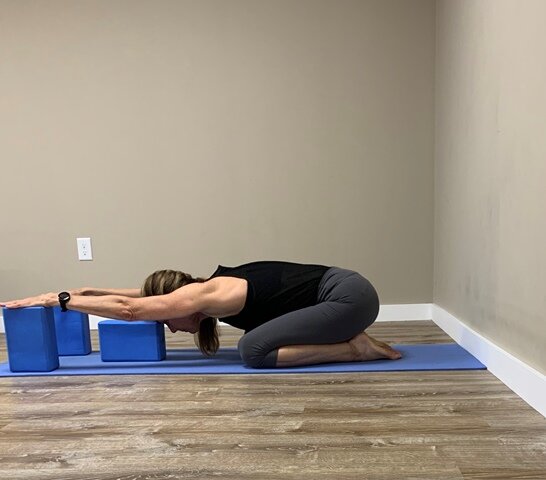Adho Mukha Virasana or Child’s Pose
What’s up with Child’s Pose? What is the purpose of this posture? I think most Vinyasa instructors regard Child’s Pose as a resting posture. Something you collapse into when you are tired or can’t hold a posture any longer. Sometimes it is used as a generic default pose as in; if you can’t do X then just come into Child’s Pose.
I call this version of Child’s Pose a “pile of laundry” because most people come into this pose as if they have just taken off their clothes and dropped them into a pile on the floor. There is no action, other than complete surrender. There is no thought as to how the body is placed. There is no skill or intelligence in the pose. Yet, it is a yoga pose and one of the definitions of yoga is that it is “skill in action”. And as a yoga pose, it is an appropriate modification for some poses but not for any pose.
When I teach Child’s Pose, and I teach it, I don’t just say “come into Child’s Pose”. I teach the posture. Child’s Pose, or Adho Mukha Virasana (which translates to Downward Facing Hero) is both a warm up posture and a diagnostic pose. It is a precursor to Downward Facing Dog and to Handstand as well as other postures with the arms overhead such as Warrior I and for back bends such as Wheel.
Looking at someone in Child’s Pose can tell you a lot about the flexibility of their hips, knees, ankles and shoulders. Can they stretch the tops of their feet so that the fronts of their ankles touch the ground? Can they bend their knees enough so that they can sit on their heels? Can they fold at the hips enough so that their chest can come to the ground? (These are all blog posts for another time.) Can they extend their arms in a straight line from their hips through their shoulders to their wrists without their elbows winging out to the sides? Let’s look at this version of Child’s Pose.
In this first photo, I have come into Child’s Pose with my hands on the floor. As you can see, there is a straight line from my hips to my armpits, but from my armpits to my wrists the angle is different and the back of my head is below my upper back. This means that the front of my body is shorter than my back body. One of the main principles of yoga is that every pose has some element of Tadasana in it. In this case it is that the front body and back body are of equal length.
Child’s Pose as a pile of laundry
Child’s Pose with skillful alignment from hips to hands
In this second photo, I have my hands and forehead on a block. This helps me to extend my sternum forward and spread my collarbones. Now I have a straight line from my hips to my hands and the front of my body is as long as the back of my body. See how the back of my head is on the same level as my upper back. This assures that the front of my body is as long as the back of my body.
The next time you come into Child’s Pose think about this. Doing Adho Mukha Virasana this way can help you prepare for Downward Facing Dog, Handstand, Warrior I, Tree and Back Bends. It can also help relieve pain in the neck and shoulders are it helps correct a forward head position.



